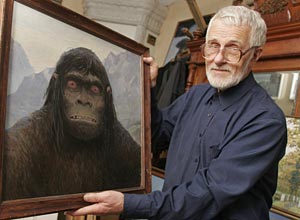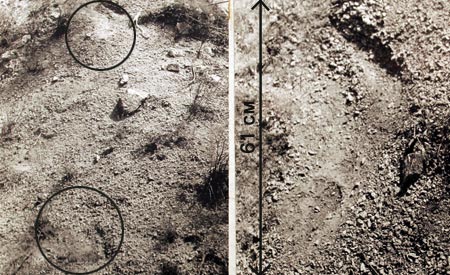
February 4, 2007

The German Study Group of Sub-Human Primates has summarized the following news out of Russia:
The website Tochikoni Rossija, a Tajik-Russian Mass Media Project published a photo (above) of the St. Petersburg artist Nikolaj Potapov with his painting of a “relic hominoid”. In the 80’s, Potapov was a participant in a “snowman” expedition in Tajikistan. There, according to the website, he witnessed a “snowman.” He portrayed the being he saw in this painting. This picture has been published numerous times in Russian journals and newspapers.
Even today, there are still no known photos of the “relic hominoid” from the former Soviet Union in which one could recognize the physiognomy. Therefore, the drawings and pictures which came from people who can draw their observation professionally and realistically are significant. Several such pictures are known from the area of the former Soviet Union. Examples of this are the drawings of an observation from the Caucasus by N. Goracharov [1] and one by a local artist from the Caucasus in the French film Almasty, yeti du Caucase.[2]
Additional professional drawings have been published from the Caucasus by Dmitri Bayanov in his book: In the footsteps of the Russian Snowman (1996): two portraits of the Almasty. According to Bayanov, these came from the eyewitness reports which were collected by Marie-Jeanne Koffmann.[3] Vadim Makarov published, in addition to the portraits and the drawing by A. Goncharova, a picture of a complete body of an Almasty – obviously by the same artist.[4] This had already been published in 1986 in a Swedish monograph by Bayanov and Burtsev and there described as “realistic”. [5]
Since Boris Porshnev’s time, the hypothesis that the Caucasus Almasty is a Neanderthal has existed. This is also a theme in the recent Russian literature on “relic hominoids”.[6] There are new digital reconstructions of the physiognomy of the Neanderthal, on the basis of skull reconstructions made by Christoph P. E. Zollikofer and Marcia S. Ponce de León on the Anthropological Institute of the University of Zürich.[7] The habitus of these reconstructions is very different from the published drawings from the Caucasus. The reproductions are missing the pronounced pongide character, particularly from the portraits published by Bayanov and Makarov.
In 2002, the Moscow “hominologists” published for the first time that Koffmann and members of her team could observe the Almasty numerous times – in daylight and at a relatively short distance too. [8] This leads to two questions on the drawings published by Bayanov and Makarov: Did such researchers/eye-witnesses also participate in the creation of these drawings? If not, how do these researchers/eye-witnesses judge these drawings? The statements made by the locals in the Caucasus are usually influenced by local superstitions and religious taboos. Often, it’s hard for them to describe their observations in a sophisticated manner. This is also a reason why the observations of the researchers are of particular importance.
1 Makarov, Vadim. 2002. Atlas of the Snowman. Moscow: Company Sputnik+, p.181 (in Russian)
2 Film Almasty, yeti du Caucase. (By Sylvain Pallix et al.,1992)
3 Bayanov, Dmitri. 1996. In the footsteps of the Russian Snowman. Mocsow: Crypto-Logos, p. 26
4 op. cit. (note 1), pp. 181, 183
5 Poshnev, B,; Bayanov, D.; Burtsev, I. 1986. Snömannens Gata. Moscow: Progress, Göteborg: Fram.
6 Vinogradova, D.; Nepomnjaskchij, N.; Novikov, A. 2003. Neanderthals alive. Moscow: Veche (in Russian).
7 Zollikofer, C.P.E.; Ponce de León, M.S. 2006. Neandertal-digital: alte Fossilien – neue Ein- und Ausssichten.
Roots/Wurzeln der Menschheit. Rheinisches Landesmuseum Bonn/Verlag Philipp von Zabern, Mainz. pp.141-150
8 op. cit (note 1), pp. 179-80; (see Atlas of the Snowman by Vadim Makarov)

These tracks of the snowman and a single track from the Pamirs have all been lumped into a single category of “snowman.”
Thanks to Mark A. Hall for pointing out this info.
About Loren Coleman
Loren Coleman is one of the world’s leading cryptozoologists, some say “the” leading living cryptozoologist. Certainly, he is acknowledged as the current living American researcher and writer who has most popularized cryptozoology in the late 20th and early 21st centuries.
Starting his fieldwork and investigations in 1960, after traveling and trekking extensively in pursuit of cryptozoological mysteries, Coleman began writing to share his experiences in 1969. An honorary member of Ivan T. Sanderson’s Society for the Investigation of the Unexplained in the 1970s, Coleman has been bestowed with similar honorary memberships of the North Idaho College Cryptozoology Club in 1983, and in subsequent years, that of the British Columbia Scientific Cryptozoology Club, CryptoSafari International, and other international organizations. He was also a Life Member and Benefactor of the International Society of Cryptozoology (now-defunct).
Loren Coleman’s daily blog, as a member of the Cryptomundo Team, served as an ongoing avenue of communication for the ever-growing body of cryptozoo news from 2005 through 2013. He returned as an infrequent contributor beginning Halloween week of 2015.
Coleman is the founder in 2003, and current director of the International Cryptozoology Museum in Portland, Maine.
Filed under Abominable Snowman, Almas, Bigfoot, Breaking News, CryptoZoo News, Cryptozoology, Yeti